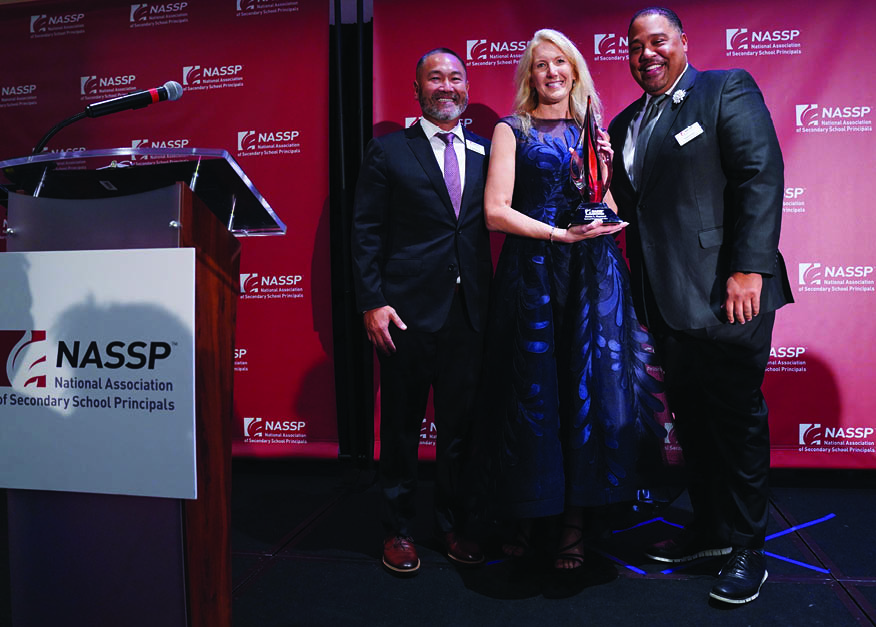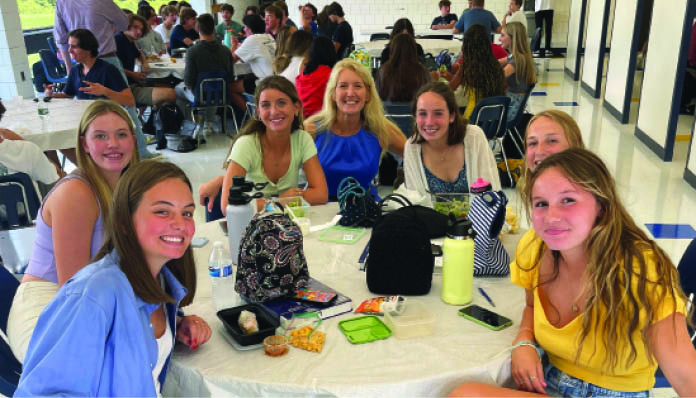Elevating Student Voice

When I was hired at Haddam Killingworth High School in Higganum, CT, the superintendent told me after my interview that there was “a magic moment” when it was clear I was the school’s next leader. The so-called “magic” happened when a senior student on the interview committee and I made a connection. I don’t remember what her question was, but I certainly remember talking with her. I answered her question, asked about her plans, and we just talked, genuinely interested in what the other had to say. I suppose that exchange foreshadowed my work at HK and the value I place on student voice. I have served as the principal for nine years since, and the input and insights of students have been a steady compass guiding my work.
At HKHS, we regularly refer to our school community as our “family” and to our school building as “our house.” The family feel we so ardently claim and maintain can’t really be a thing without student voice being highly valued and consciously developed. Located in the lower Connecticut River Valley, HKHS serves the two small towns of Haddam and Killingworth, whose combined population is about 15,000. Spanning 82 square miles, we are the largest geographic district in the state, yet our enrollment of 550 students makes us a rather small school. Despite our sprawling residential geography, HKHS is a close-knit, familial school community with very engaged families.
Including Student Voice in the Governance Structure

My first and best move in building student voice has always been to weave it into the Monday through Friday routine of a school. In my view, it’s critically important to get kids used to speaking to groups of faculty members, addressing the Board of Education, and speaking openly with me. All school leaders can introduce opportunities to include student voice. The most direct way is to authentically include students in the governance structure of the school.
When I arrived at HKHS, we had an active student council composed of elected leaders from each class. To complement their work, I created a student advisory team—the “A-Team”—in my first year. The A-Team is an active student group that meets with me monthly to address issues of student life, contribute suggestions and improvements, and vet some of my “wilder” ideas before I pursue them. They have had a direct, positive influence on school procedures and Board policies such as the dress code and our athletic policy regarding substance abuse. Student leaders have presented at faculty meetings and facilitated the creation of new norms around testing, homework, and parent communication. They have met with our department heads and administrative team to help raise awareness of LGBTQ+ issues and to suggest additions to our curriculum.

Three years ago, as student voice grew to become more visibly central to our school’s culture, our athletic director pitched the idea of a “Captain’s Council” to me. The Council brings student leaders together with our athletic director and administration for leadership training so that team captains can more effectively lead their peers to make good decisions. Approximately 75% of our student population plays at least one sport, so engaging the student leaders of our athletic program was a high-leverage move. On numerous occasions, I have turned to our Captain’s Council to influence student behavior and hear the student perspective on any number of topics. If there is a controversy or an issue involving social media, student relationships, or other schools, we call on these students as high-impact communicators to reach the most students.
More recently, when the districtwide diversity committee struggled to gain traction in supporting initiatives to build more inclusive schools, I suggested that our school go its own way and launch the “Student Equity Team.” Still in its seedling stage, the Equity Team’s mission is to help effect positive change in honoring all types of diversity in our school. Given their charge, the students on this team asked for training on how to be effective leaders. They also suggested more training for teachers, who are most often in the position of noticing the sometimes-subtle negative exchanges between students.
Schoolwide professional development for teachers has been directly informed by student voice. For instance, our school year began with carefully tailored training for teachers by the National Conference for Community and Justice. This was followed with the “Names Can Really Hurt Us” assembly program for students and teachers hosted by the ADL. This intense culture-building program centers around student voice and includes powerful, personal accounts of bias, an open opportunity for student response, and the creation of improvement action plans written by small student groups (and led by trained student/teacher facilitator duos). To bring the work full circle, the A-Team, Equity Team, and Captain’s Council now lead the charge on those action plans. Who better to positively influence the greater student population than the student leaders?
Responding to School Climate
Requiring the most agility but yielding the most powerful results, we thoughtfully and purposefully position student voice at the center of our school in order to protect and nurture our positive school climate when issues arise. Doing so takes energy and trust, modeling and coaching, and requires an already-strong base of established student voice.
In February 2018, the school shooting tragedy in Parkland, FL, impacted our students more than other school tragedies in recent years. For a variety of reasons, our kids “felt” Parkland more personally. Suddenly, they were nervous about coming to school. In turn, parents were nervous and spoke out at a Board meeting, worried about whether our schools were safe. The issue was obviously unsettling to our school community and began to have an impact on learning in our classrooms. We needed a swift response, and we needed it to go beyond our normal letters home and reassurances of all the best school safety protocols.
As a result, we worked with a small group of students and teachers to facilitate “town meetings” in which each grade level convened in the auditorium to discuss school safety. At each meeting, I started the conversation and gave students an opportunity to process their feelings about Parkland. We shared common fears and a deep desire to ensure that our school family was safe. Students, teachers, school administrators, and local police all shared information about the numerous safety measures in place to protect our school. Students could ask questions and, importantly, we concluded the conversation by emphasizing each individual’s power to keep “our house” safe.
We then invited students to participate in a student-led school safety rally, which was HKHS’ spin on the national school walkouts scheduled at schools across the country. Students worked with me to plan the event, which featured student speakers, special music, and a collective commitment to keep our family safe. It was positive, affirming, and empowering and enabled us to return to the business of teaching and learning.
In March of 2020, our school had a brief but troubling uptick in racial incidents involving the use of racial slurs in casual conversation and so-called jokes. A Confederate flag emblem on a student vehicle became the center of tense debate, and a flurry of social media activity in response to the discipline that had been meted out inflamed the matter even more.
This issue had come up so quickly that there wasn’t time to schedule some of the more traditional programming to strengthen diversity sensitivity. We, as a school, needed to do something immediately to change course. I called in a small group of students, representing a wide variety of friend groups, each a natural leader of their peers, and asked for their help. I chose students who I knew would be invested in restoring harmony in our hallways and whose opinion and influence would reach a good number of their peers. Next, we asked several influential teachers to be part of addressing this issue. Over the next couple of days, this group of students, teachers, and I worked together with urgency to plan small “town meetings.” We had a common mission: to restore a sense of safety and belonging to every member of our school community and to set clear expectations as to how we interact with each other in and around our house.
On the day of the meetings, the students, teachers, and I placed ourselves on stools around the audience. A student led off the discussion by recounting a few of the things that had happened, followed by another student who clearly articulated that this isn’t who we are as HKHS, and another who reminded the group that our school is a family and healthy families accept each member as a valued part of the whole. A health teacher joined in, referencing a relationship lesson every student had experienced. A school counselor shared the essence of a conversation she had had with a student who was personally hurt by recent events. Students in the audience were invited to share their thoughts and reactions, and they did. They were encouraged to candidly ask questions, and they did.
When one student asked how to move past some of the more hateful rhetoric he had heard, I gave him my most genuine, unguarded response: “Moving forward requires change on the part of those who have misstepped but also forgiveness by others in order to allow room for that change.” I pointed out that this is what healthy families do—we change, we grow, and we forgive. An important shift occurred through those meetings, a big first step toward restoring peace. And, although our school culture work would then be interrupted by the COVID shutdown, we continued it once school reopened.
More spontaneous, whole-school conversations have become part of our school culture as students have developed their voice and confidence to lead. A year later, when a cluster of student suicides in surrounding districts and very serious attempts in our own district occurred, three concerned senior boys approached me, desperately wanting to know what our school family could do to guard against more loss. After I finished detailing all the strategies and support our school had put in place, they told me how appreciative they were. But I realized something: They wouldn’t have known about them if they hadn’t directly asked me!
Not communicating clearly to our kids right away and then asking them to help spread the word was a serious miss. Indeed, we clearly know the importance of student voice in navigating tough stuff. Yet the issue of teen suicide had thrown me, and I had forgotten to go there first. On the spot, I asked the boys to work with me to lead a series of class meetings on mental health and suicide prevention. I included appropriate resource staff, and we encouraged the boys to take the lead on the conversations in our now-familiar town meeting arrangement. They shared with their peers information about resources and support, including some new layers of assistance we had envisioned together, and opened conversations for our students with trusted peers and adults. And, although we never quite let down our guard with respect to the risks of mental health crises and self-harm among teens, our school family was able to exhale a bit and regain our footing.
The issue of mental health was the third one in four years that we had tackled with the help of students. Our kids have developed an institutional memory that their voice is critically important. Each time our house has been challenged, students have sought my approval and have trusted me to coach and support them as they lead their school community through tough issues. I consider that high praise. They matter. They know it. This is their school.
Listening to Our Kids
Like many educators, I am a parent. My greatest joys and challenges in life have come from that role and, although there is no secret sauce to parenting, the one thing that has worked best in my own journey is listening to my daughter. In fact, when she was about 10 years old, I made my best friend promise that “If anything happens to me, listen to her…” Because, while I couldn’t predict what struggles my girl might go through in life, her best protection would be an adult who would actually hear her—her thoughts, her feelings, her needs.
The same is true of all kids everywhere. If we just listen, listen hard, listen carefully, listen for what is said and not said, listen for the real message behind the words, our kids tell us what they need. In that way, we have an opportunity to provide it. Just as I honor my daughter’s voice in my family, I honor my other children’s voices in my school family. In the end, we can’t be a family without hearing and valuing the voices of all our kids.
Donna Hayward is the principal of Haddam Killingworth High School in Higganum, CT, and the 2023 National Principal of the Year. She will be speaking at Ignite 2023 in July.
To register for Ignite 2023, visit ignite.nassp.org.
